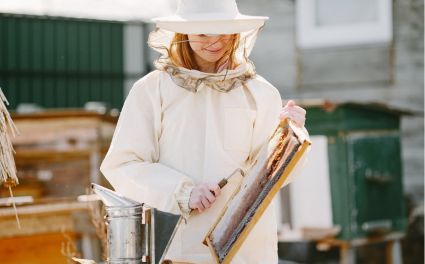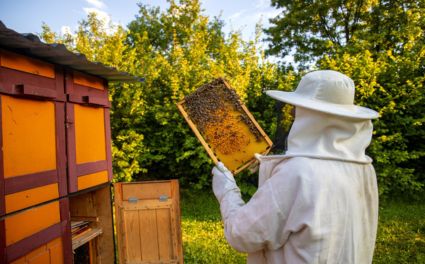Beekeeping is an incredibly rewarding pursuit that connects humans with nature’s most productive pollinators — the honey bees. However, safety is the top priority when managing hives. Among all essential beekeeping equipment, one of the most vital is the beekeeping veil. This article explores the different materials used in beekeeping veils, their benefits and limitations, and how choosing the right gear can enhance both safety and comfort.
Whether you are a beginner learning through Learn Beekeeping or a seasoned beekeeper managing several hives, understanding veil materials can make a significant difference in your beekeeping experience.
What Is a Beekeeping Veil?
A beekeeping veil is a protective cover that shields the face and neck from bee stings during hive inspections. It’s often paired with a full beekeeping jacket, beekeeping suit, or beekeeping gloves for maximum protection.
These veils are made from different materials — such as cotton, synthetic fibers, or mesh — each offering a balance of protection, comfort, and visibility. The goal is simple: keep the beekeeper safe while maintaining a clear view of the hive and ensuring proper airflow to prevent overheating during work.

Key Features of a Quality Beekeeping Veil
Before comparing materials, it’s essential to know what makes a good veil.
-
Visibility: A high-quality veil should provide crystal-clear vision while working with bees.
-
Protection: The material should prevent bee stings even under pressure.
-
Comfort: Breathability is crucial, especially in warmer climates.
-
Durability: A strong fabric ensures longevity and resistance against wear and tear.
-
Fit: Adjustable elastic or drawstring features ensure a snug and comfortable seal.
When paired with beekeeping trousers and proper ankle protection, veils form part of a complete suit that defends against unexpected stings from head to toe.
Cotton Beekeeping Veils
Benefits
Cotton veils are a timeless choice for many professional beekeepers. The natural fibers of cotton provide excellent comfort, softness, and breathability. These veils are often part of beekeeping jackets or beekeeping suits that prioritize comfort during long hive inspections.
Cotton veils are also static-resistant, helping to keep bees calm around the head and face. Moreover, they offer a natural aesthetic that complements traditional beekeeping gear.
Limitations
On the downside, cotton absorbs moisture and takes longer to dry, making it less ideal for rainy or humid environments. It can also feel heavier compared to synthetic or mesh veils. Beekeepers working in tropical or warmer regions often prefer lightweight alternatives.
Mesh Beekeeping Veils
Features and Advantages
Mesh veils are gaining immense popularity for their unmatched visibility and ventilation. The fine woven mesh allows air to flow freely, reducing heat buildup and making them perfect for summer beekeeping. These veils are often integrated into ventilated beekeeping suits or beekeeping gloves that combine breathability with full-body protection.
Beekeepers particularly appreciate mesh veils for activities requiring precision — such as examining brood frames or checking for diseases like varroa mites — since clear vision is vital.
Durability Considerations
While mesh offers superior comfort, it is more delicate compared to thicker cotton or synthetic materials. Mesh veils can tear if mishandled, so proper storage and gentle cleaning are important. Some modern designs now use reinforced mesh for improved longevity, balancing both lightness and strength.
Synthetic Fiber Beekeeping Veils
Synthetic veils blend advanced materials like polyester and nylon to achieve an ideal mix of durability and breathability. They’re resistant to weather conditions and are easy to clean, often used in professional beekeeping suits for heavy-duty operations.
Their quick-drying nature makes them suitable for various environments, and they maintain visibility even after multiple washes — a reason many commercial beekeepers favor them for everyday use.
Maintaining Beekeeping Veils
Proper care extends the life of any protective gear. Regardless of whether it’s cotton, mesh, or synthetic, cleaning according to manufacturer instructions is key.
-
Wash gently using mild detergents.
-
Avoid wringing or folding mesh veils too tightly.
-
Air dry to prevent material shrinkage.
For more maintenance guides, visit the Learn Beekeeping section on OZ Armour’s knowledge hub. These resources also cover tips on removing a bee sting safely — an essential skill every beekeeper should master.
Beekeeping Veils for Kids
Introducing children to beekeeping can be an exciting learning experience. However, safety comes first. OZ Armour offers specially designed beekeeping suits for kids that come with comfortable veils and durable stitching. These kid-friendly suits are lightweight and provide full coverage from head to toe.
For extra comfort, consider pairing them with pink bee suits, a fun and safe option for younger or beginner beekeepers.
The Role of Beekeeping Veils in Full Protection
Veils work best when combined with other safety gear. A full set typically includes:
-
Beekeeping Suits – for head-to-ankle protection.
-
Beekeeping Jackets – ideal for short inspections or hot weather.
-
Beekeeping Gloves – protect hands while maintaining dexterity.
-
Beekeeping Trousers – flexible, secure, and breathable leg protection.
-
Beekeeping Ankle Protection – prevents bees from entering through pant cuffs.
Each piece complements the veil to create a complete line of defense for every beekeeper.
Exploring Related Beekeeping Insights
Understanding bees and their behavior helps improve safety and productivity. Here are some fascinating reads for those looking to deepen their knowledge:
These articles from OZ Armour’s educational library help beekeepers identify species, understand differences like bumblebee vs honeybee, and even learn how to distinguish between a beehive or wasp nest — crucial for safe hive management.
Beekeeping Equipment and Tools
Alongside veils, other beekeeping equipments plays an important role. From hive tools and smokers to feeders and suits, every piece contributes to efficient hive care. OZ Armour’s extensive range of tools and accessories is designed to meet the high standards of professional beekeepers across the USA, UK, and Europe.
Why OZ Armour Is Trusted Worldwide
OZ Armour is globally recognized for producing advanced, high-quality beekeeping apparel. The brand emphasizes durability, functionality, and comfort — qualities essential for professional and hobbyist beekeepers alike. Each veil, glove, or suit undergoes stringent quality checks to ensure maximum protection against stings while maintaining superior ventilation and visibility.
Their global reach — including stores in the US, the UK, and Europe — ensures beekeepers everywhere have access to trusted safety gear.
The brand’s dedication extends beyond just products; it promotes awareness about honey bees, sustainability, and proper hive management practices through its news blog section.

Conclusion
In the world of beekeeping, the veil is not just an accessory — it’s a critical line of defense that enables confidence and calm while working with bees. The choice between cotton, mesh, and synthetic materials depends on climate, comfort preferences, and working style.
Whether paired with a beekeeping jacket, a full beekeeping suit, or lightweight beekeeping trousers, a well-designed veil is an essential tool for every beekeeper. Complement your gear with gloves, ankle protection, and kids’ suits to ensure full-body safety.
As showcased by OZ Armour’s globally trusted designs, innovation in material, fit, and visibility continues to redefine modern beekeeping protective wear.
For more insights into beekeeping life, bee nest behavior, and practical tips like removing a bee sting, explore Read More Blogs About Beekeeping and dive into the Lives of Bees to truly understand the art and science behind this ancient practice.



